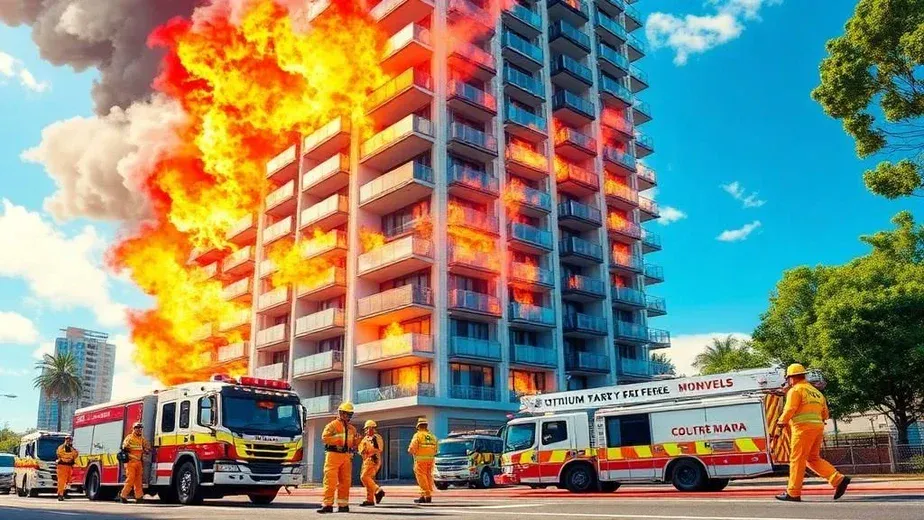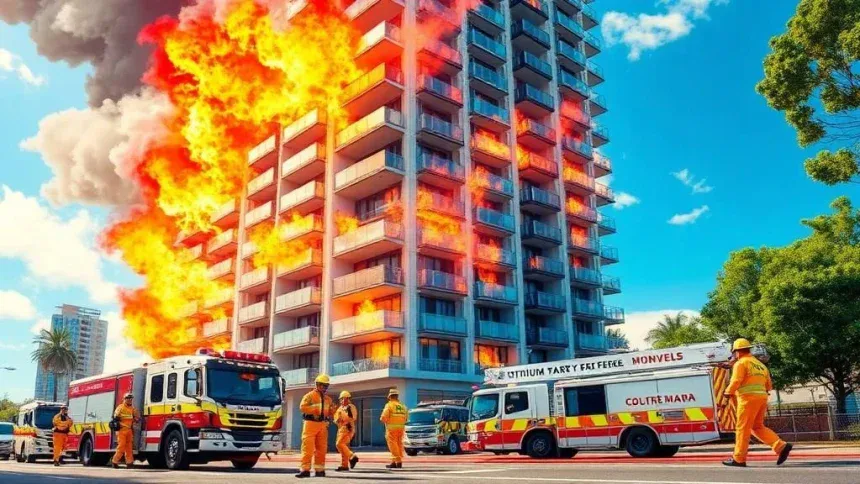Excerpt: Lithium battery fires are rising in Australian towers. This guide shows how police, fire, paramedics and SES can work with residents and building managers to prevent incidents, prepare safe evacuations, respond rapidly, and recover well—without leaving vulnerable people behind.
On this page

Prevention — Stop lithium battery fires before they start
Lithium battery fires in high‑rise buildings often begin during charging, after impact damage, or from non‑compliant replacement packs. Reduce risk with safe purchasing, storage and charging, and by keeping exit paths clear.
- Buy devices and chargers from reputable suppliers; look for compliance and manufacturer specs. See Product Safety Australia.
- Follow manufacturer charging limits; avoid overnight charging and soft furnishings.
- Never charge in corridors, stairwells or near the front door. Maintain egress.
- Use dedicated rooms with smoke detection and ventilation for fleet/strata charging.
- Replace swollen, damaged or water‑exposed batteries—do not tape or modify cells.
- For facilities: align with AS 3745 (planning for emergencies) and maintenance programs in AS 1851.
- Educate residents about early signs: hissing, popping, sweet/solvent odour, vapour, heat.
- Retailers and delivery hubs: segregate charging bays; install signage and spill/fire blankets rated for batteries.
- Refer to guidance from Fire and Rescue NSW — Lithium‑ion battery safety and CFA — Lithium‑ion battery safety.
Preparedness — Plans, training and kits for towers
Preparedness turns a dangerous surprise into a controlled incident. Build layered readiness with the building’s owner’s corporation, on‑site managers, and local emergency services.
Residents & households
- Keep a clear exit path; store e‑bikes/scooters away from sleeping areas.
- Charge on non‑combustible surface; use original charger; never daisy‑chain powerboards.
- Install photoelectric smoke alarms; test monthly; replace batteries annually if applicable.
- Know two ways out; practice a simple fire drill twice yearly.
- Save emergency contacts in your phone (see Quick List below).
Building managers & committees
- Map micro‑mobility storage/charging areas on evacuation diagrams (AS 3745).
- Ensure sprinklers, hydrants, hose reels and smoke control are maintained (AS 1851).
- Create an incident log and contact cascade (concierge, strata, security, lift contractor).
- Run annual drills including after‑hours scenario and vulnerable residents plan.
- Keep a Grab‑Pack: floor plans, keys, resident lists (privacy‑aware), hi‑vis, torches, P2 masks, radios.
Responders (police, fire, medical, SES)
- Pre‑plan tower access (hydrant/boosters, fire control room, egress stairs, refuge floors).
- Tabletop a “battery off‑gassing in unit” scenario; define isolation, ventilation and cordons.
- Cross‑train on hazards of thermal runaway and re‑ignition.
- Carry P2/N95 for residents; allocate a Safe Refuge/triage area downwind.
- Establish interoperable comms (radio channels, common lexicon).
Response — First actions for lithium battery fires
Priority: Life safety, containment, ventilation and re‑ignition control. Maintain stairwell integrity and avoid smoke spread.
- Size‑up: Identify apartment, floor, and if the device is off‑gassing or actively burning. Ask about prior damage or charging.
- Isolate & contain: Close the room door; turn off power at unit if safe; keep doors to corridor shut.
- Evacuate: Police to manage corridor and lobby clearance; use PA/alarms. Prioritise mobility‑impaired residents.
- Suppression: Fire crews use water for cooling and knockdown; consider water‑filled containment for small devices when feasible. Avoid moving compromised packs.
- Ventilation: Coordinate mechanical systems; prevent smoke migration to stairs/lifts. Lifts remain out of service for fire travel.
- Medical: Paramedics assess for inhalation injury, eye irritation, burns; monitor CO exposure; consider observation for delayed effects.
- LACES/Lookouts: Assign lookouts for re‑ignition; establish collapse/fragment hazard zone around the device.
- Handover: Document actions, times, and residual heat checks; brief building manager and police for scene security.
Guidance varies by state/territory; see agency pages under Links & hotlines.
Recovery — Clean‑up, health and returns
- Scene safety: Cool and monitor with thermal checks; isolate debris in non‑combustible container outdoors where possible.
- Decontamination: Ventilate affected unit and corridor; wipe residues with damp methods; avoid dry sweeping.
- Health: Advise residents to seek medical care for persistent cough, eye irritation or breathing difficulty.
- Insurance & repairs: Photograph damage; contact insurer; confirm electrician checks of circuits and RCDs.
- Debriefs: Conduct crew and building debrief within 72 hours; capture lessons and update diagrams and resident notices.
- Community support: Link affected residents to local council recovery teams and hardship grants where available.
How it works — The science in plain language
Thermal runaway is a chain reaction inside the battery. A damaged or overheated cell releases heat and flammable vapour; neighbouring cells heat up and the reaction spreads. The fire can look small, then flare repeatedly. Water cools effectively; complete extinguishment may require prolonged cooling and containment to prevent re‑ignition.
Roles & coordination — Who does what
Fire services
Command suppression, ventilation and hazard control; liaise with the building fire control room; manage thermal monitoring and overhaul.
Police
Manage evacuations, cordons and traffic; protect scene; support welfare checks; coordinate reunification areas with building staff.
Paramedics
Assess, treat and transport; set up triage downwind; monitor respiratory symptoms; consider vulnerable residents for observation.
SES / Council
Provide lighting, barriers and community welfare support; assist with temporary accommodation and building access post‑incident.
ICS basics: Use a single Incident Controller with Operations, Planning and Logistics functions scaled to incident size. Agree a common channel, plain language, and a single point of contact for the building manager.
Equipment & tools — What helps and how to use it safely
- Cooling water supply: Hose reels/hydrants for sustained cooling; protect drains where contaminated runoff is a concern.
- Battery fire blankets/containers: For small devices if safe to deploy without moving an off‑gassing pack.
- Thermal imaging: Detect hidden heat; repeat checks before handover.
- PPE: Structural PPE and SCBA for crews; P2 masks for residents during evacuation.
- Signage & barriers: Police tape, cones and floor wardens to keep stairs clear.
- Ventilation control: Coordinate with building systems; avoid pushing smoke into stairs or occupied levels.
- Waste isolation: Non‑combustible bin or skip, outdoors, with monitoring for re‑ignition.
Field scenarios — Brief case studies
1) Charger fault on Level 14
Before: Resident using third‑party charger in hallway. During: Smoke triggers alarm; door closed by neighbour; fire crews cool and contain; police clear corridor. After: Unit ventilated; manager issues building‑wide charging advisory.
2) Damaged e‑bike after crash
Before: Bike stored indoors post‑impact. During: Off‑gassing detected; device left in place, cooled with water pattern; paramedics treat two for irritation. After: Battery isolated outdoors; thermal checks at 30‑minute intervals—no re‑ignition.
3) Fleet charging room event
Before: Delivery hub in basement; poor ventilation. During: Sprinklers hold fire; crews overhaul; SES provides fans and lighting. After: Council assesses; business updates SOPs and installs compliant chargers.
Checklists — Print‑friendly
Households & residents
- Store and charge devices away from exits and bedrooms.
- Use original chargers; avoid overnight charging.
- Replace damaged/swollen batteries promptly.
- Keep a torch, P2 masks and medications ready near the door.
- Know two ways out; help neighbours who may need assistance.
Building managers
- Update evacuation diagrams to include charging/storage rooms.
- Service fire systems as per AS 1851; keep records accessible.
- Brief concierge/security on battery hazard cues and 000 activation.
- Maintain a resident assistance list (privacy‑aware) for evacuations.
- Run and record at least one after‑hours drill each year.
Responders
- Carry extra P2 masks for residents and staff.
- Pre‑plan lobby triage and safe refuge locations.
- Assign lookout for re‑ignition; implement on‑scene thermal checks.
- Agree comms and staging with police before stair deployment.
- Document actions and timings for handover and reports.
Accessibility & inclusion
- Children: Teach “stop, leave, close the door, tell an adult”. Keep a small comfort item in the Grab‑Pack.
- Older adults: Consider door knock buddies; place large‑print evacuation maps at lifts and on noticeboards.
- Disability: Register assistance needs with building manager; plan for refuge points and evacuation aids.
- Pets: Keep a carrier and lead near the door; add vet contact to your emergency list.
- Language access: Display multilingual battery safety pictograms; link to translated agency advice where available.
FAQs — Lithium battery fires in high‑rise apartments
Can I use water on lithium battery fires?
Yes for cooling and knockdown, especially on small devices. Expect re‑ignition risk and continue cooling and monitoring. Follow local fire service procedures.
Should I move a smoking battery outside?
No. If it is off‑gassing or hot, do not touch it. Evacuate, close the door to contain smoke, and call 000.
Are third‑party chargers safe?
They may not match the required voltage/current and can overheat cells. Use the charger supplied or specified by the manufacturer.
What are signs of impending failure?
Swelling, unusual heat, hissing, popping, solvent odour, smoke or vapour. Stop charging, isolate the area and evacuate.
Is a device safe after it cools?
Not necessarily. Cells can re‑ignite. Do not reuse a compromised battery; arrange safe disposal via your local council guidance.
Do strata rules allow corridor charging?
Corridors are usually part of the required egress path and must be kept clear. Check your building by‑laws and state regulations.
Which extinguisher should I buy?
For most homes, a water mist or ABE extinguisher and a fire blanket are useful. Always prioritise evacuation and calling 000.
Are disposal bins for batteries required?
Provide safe collection points per local council waste guidelines; never place damaged lithium batteries in general waste.
Links & hotlines — Official Australian sources
- Fire and Rescue NSW — Lithium‑ion battery safety
- CFA Victoria — Lithium‑ion battery safety
- Product Safety Australia — Recalls & guidance
- VIC SES — Storm & flood support • NSW SES
- Healthdirect — Smoke and your health
- State warnings: Vic Emergency • NSW RFS • QFES • DFES WA • CFS SA • TFS • NT PFES • ACT ESA
Note: Standards and procedures may vary. Always follow your local agency’s current instructions.
Emergency Contacts — Quick List
- 000 — Fire, Police, Ambulance
- Vic Emergency warnings & incidents
- SES (storm/flood) — state portals
- Local council after‑hours: see council website for building safety and waste/disposal guidance
- Healthdirect (non‑emergency health advice)
- Lifeline (13 11 14) for crisis support
Preparedness in 5 Minutes
Home
- Move chargers off soft furnishings; clear your exit path.
- Label the main power switch; show everyone how to call 000.
- Place a torch and P2 masks near the door.
Workplace
- Designate a supervised charging area on a non‑combustible surface.
- Post “If smoking/overheating — evacuate, close door, call 000”.
- Check extinguisher locations and access to hose reels.
For crew leaders — Briefing & handover
- Briefing: Objectives, hazards (thermal runaway, smoke migration), egress protection, comms, medical staging, re‑ignition plan.
- Tasks: Fire attack, ventilation control, police cordon, triage area, lookout, thermal monitoring, liaison with building manager.
- Handover: Heat readings, isolation steps taken, any damaged circuits, waste storage location, resident welfare follow‑ups.
Credits & review notes
Reviewed by: Senior Firefighter / Building Safety Officer • Updated: .
References in text include Australian guidance from FRNSW, CFA, Product Safety Australia, and general alignment with AS 3745 and AS 1851. For state‑specific procedures, use the agency links above.






